For all the right reasons
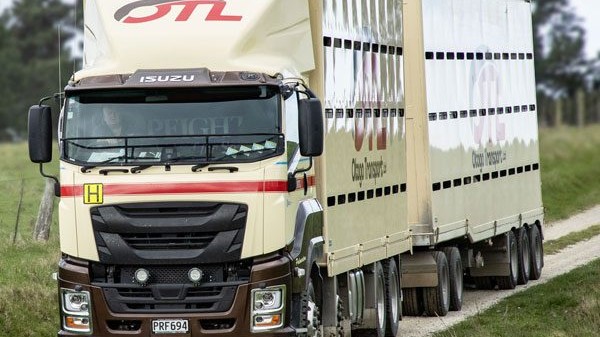
We’re back on a truck bent this month. Isuzu’s latest heavyweight GIGA has a new – somewhat polarising – face. On the other hand, like archrival Hino, it has arrived holus-bolus into the 21st-century automotive safety enclave. It is festooned with protective paraphernalia, but has the big Suzi retained all that made people love it – the reliability, the simplicity, and the price? To find out, we went to a brand stronghold, and a line of work that has made the GIGA many long-time friends.
To say Isuzu’s heavy- truck range has positively impacted the balance sheets of many well-known New Zealand carriers across the years is an understatement in the extreme. Talk to people like Merv and Ed Solly in Golden Bay, or Bruce Stephenson in Waipawa, and the marque’s virtues flow forth. Rural cartage men aren’t prone to hyperbole; their respect for the Isuzu product is largely focused on the simplicity of construction, capability, price and above all else, reliability. ‘When you turn the key, it starts’. It’s an attribute we hear spoken of the Isuzu product so often in our travels. And let’s face it, Japan’s manufacturers have owned automotive reliability for almost 60 years.
Yes, owners agree there was a sticky patch at Isuzu’s heavy end mid-way through the century’s first decade: trucks that didn’t live up to historical expectations and dropped the baton somewhat. However, the brand’s reputation before and since has allowed it a glitch now consigned to the archives – forgiven but not forgotten. As they say, a lesson taken on board qualifies as both education and dignity.

For the transport business owner, having a truck that turns up on the go line every morning means many of its potentially less endearing qualities can be forgiven; things like heavier tare weight, lack of power and lesser high-tech swank encompassing things like safety suites. That last one had deeper tentacles for Isuzu and Hino, its key competitor in the ‘uncomplicated truck’ space for much of the past decade. Body builders will regularly convey the ease of working on both brands due to the simplicity of the trucks’ engineering and electrical architecture, especially when fitting expensive ancillary gear, such as cranes. It made those applications a happy hunting ground for sales staff. With the competitive upfront cost of the truck and a simplified fitout, customers could entertain a new bumper-to-bumper set-up with an invoice that didn’t send the balance sheet into apoplectic seizure.
Likewise, the rural sector. The vagaries of weather, meat schedules, wool prices and dairy auctions always mean a rural carrier must cut its cloth according to primary industry performance over longer periods; where there’s feast, there will surely be famine. Today’s lush pasture is tomorrow’s drought.
Strong, reliable, competitively priced trucks meant the Japanese marques always found a happy home in the primary industry. In recent years, however, that niche has come under pressure. The rise of dairying in the county’s southern extremities, the rationalisation of meat processing locations and kill profile, and live cattle exports – although now defunct – are reasons New Zealand livestock haulage is today an end-to-end game requiring bigger, higher-output trucks. The other key component is, of course, the competitive labour market for drivers.
But that doesn’t mean Isuzu and Co’s utility in regional rural cartage is any less appealing. Where the need to dart away to far-off places is only an occasional requirement, such machines still offer an incredibly compelling option.

Hanging 10 on the surfboard of simplicity was always going to be a fleeting opportunity in time. ‘We’, our customers, and insurers, demand far more from our trucks in 2023 when it comes to pillars like occupant preservation and contribution to productivity. Having the truck stop all on its own for an errant road user the moment you glanced in the mirror to check out an unfamiliar noise down the back might well mean you, your lorry and your trolley will live to fight another day. And let’s not forget it helps avoid the colossal emotional and financial price paid by all parties involved in an unscheduled coming together. In a scenario like that, advanced emergency braking might well mean a two pack of Jockey skants – one pair for the perpetrator and the other for the aggrieved – at about $32.50, will likely be the only cost incurred.
As such, the heavy end of the Isuzu and Hino product lines have had the clever wand waved over them in the past couple of years and have taken their place at the big truck safety table.
For those who follow wider industry manoeuvrings, you’ll be aware there’s a hell of a lot going on as the globe’s OEMs all reset themselves in ways that optimise investment in research and development and balance-sheet health, ensuring they don’t succumb to Darwin’s theory. This year, Toyota and Daimler Truck have merged their respective Hino and Mitsubishi Fuso Truck and Bus brands. But the one we’re most interested in this issue is Volvo selling off UD to Isuzu in 2021 as part of an ongoing alliance. (Interestingly, in 2021, Isuzu, Hino and Toyota also announced a collaboration and equity swap.)
Key bullet points in the Volvo/Isuzu press material accompanying this shift in the tectonic plates of heavy-vehicle manufacture were: “The alliance between the Volvo Group and Isuzu Motors is set to build a long-term and robust relationship. Alliance work is now entering the next phase to derive potential synergies…” and “Forming a technology partnership, intended to leverage the parties’ complementary areas of expertise within both well-known and new technologies and creating a larger volume base to support investments for world-class technology.”
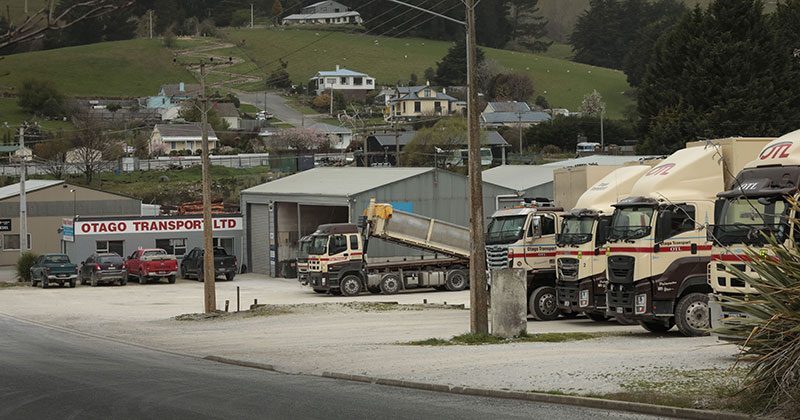
Palmerston – Perfect
We’ve been looking for a new GIGA in a rural environment since launch. Apart from the fact we love rural cartage, we wanted to see if the new trucks retained everything that makes them a solid performer in regional rural transport. As always, the wait was well worth it.
Located on SH1 roughly 74km north of Dunedin, Palmerston is home to the 18-truck Otago Transport Ltd (OTL) fleet, servicing the primary sector in and around its Otago base.
An archetypal rural transport business, OTL’s depot on Tiverton Street comprises all the core necessities: an office, fert shed, fuel bowser, wash, workshop, loading ramp and parking. In classic South Island style, the trucks drive straight off the yard, and away.
The fact the company’s cream, brown and red livery bears a striking resemblance to that of Balclutha-based Clutha Valley Transport is no coincidence. OTL was set up in 1998 by Clutha Valley owners Evan ‘Chow’ Williams, Grant Paterson and Howard Paterson. Howard owned a chicken farm in nearby Waikouaiti, providing a work base for the initial three-truck operation that comprised a cattle truck, a drop-side unit and a spreader.
When Howard passed in 2003, driver Carey Turner bought his share of OTL. A Karitane lad, Carey was born into rural transport. His dad Russell ran Clulee Transport (A S Clulee Ltd) for a spell. Carey had served his time as a mechanic and worked in Australia and the United States prior to moving home and taking the job at OTL. That was 26 years ago.
Evan Williams’ sudden death following a short battle with cancer in 2020 resulted in Carey taking the remaining OTL shareholding, and both companies still have a close association.
OTL is an easy business to hang around, and a more humble bloke than Carey you will not find. He asked that we acknowledge the company founders in this story, and in terms of his own story, not much more, such is the man’s character.
Like so many of his ilk in this neck of the woods, Carey knows his customers inside out and is always at work – whether physically there or not. He’ll probably be out in the flea truck if he’s not on site. “Local areas still need local transport. The big boys are after the one-pick-up loads, but someone is needed to do the six-pick-up loads and piecemeal service work.”
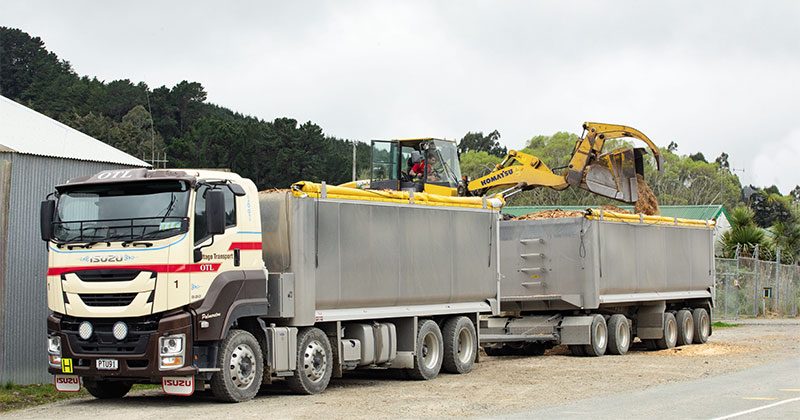
Not one, but two!
While the Palmerston-based rural carrier has an association with the brand back to the turn of the century, OTL is an Isuzu stronghold today for all the reasons we’ve listed. “They’re a good, reliable machine at a good price,” says Carey. “We’ve always dealt with Dunedin dealer Cooke Howlison, and they’ve always been great. The trucks come with a 500,000km, five-year warranty, and we do about 110,000km a year. We don’t have much in the way of hills; they’re a no-brainer. I have a good steady crew. They know what we run, it’s as simple as that.”
At the risk of pushing the boat out, we will say at this point that it’s not surprising his crew of drivers is steady. If you didn’t know who owned the business on your arrival, you’d never be able to pick it in a million years. OTL is led from the front – entirely. As a mechanic, Carey maintains the units. Every driver carries tools and is trusted to be responsible for their own truck. It’s the antithesis to many other contemporary trucking operations.
Our visit would turn out even better than we’d hoped. We were allowed access to not one, but two of OTL’s four new 8×4 GIGAs; one on bulk tip work driven by 25-year veteran Peter Stevenson, and the other a stock unit driven by local identity Colin Foley. Colin is currently on 19 years of service on his second stint at OTL. But wait, it gets better. Peter comes from a non-Isuzu background, and Colin from a multiple-Isuzu background, so Peter can tell us how the new GIGA compares with other trucks he’s driven, and Colin can tell us how it compares with previous incarnations.
Little did we know, but we were about to embark on two enjoyable days with two bloody awesome blokes. You know the sort, if you were racing to catch a plane and knew they were in the pub you just passed, you’d miss your plane. What better opportunity to get a full perspective on the new model in a no-frills operation it couldn’t be more suited to?
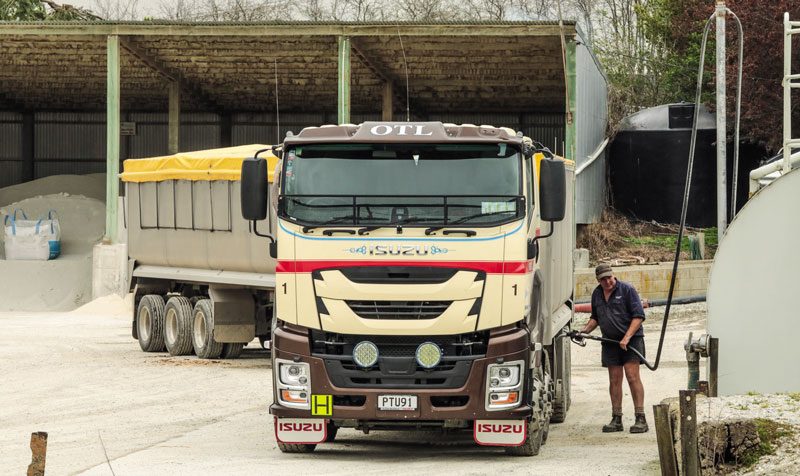
Being bolder
We’re perched alongside SH1 at the Waitaki River Bridge, the border of Otago and Canterbury about mid-way between Oamaru and Waimate. A constant stream of trucks rolls by as we wait to capture some images of OTL’s new GIGAs. It’s a great opportunity to gauge some context – one of the common comments we’ve encountered about the new GIGA is often along the lines of ‘I’m not sure about the way it looks’. And in the context of the myriad trucks to pass us in the time it takes for two of OTL’s new GIGA stock trucks and two of its bulkies (one of which is previous generation) to come rolling past, in all honesty, the new trucks fit in quite well with their contemporaries.
Each OTL unit has been treated to a dash of individuality. One stock unit retains the standard CYJ530 dark-chrome grille, the other has been wrapped matte black, while the bulkie’s has been painted body colour. There’s a bit of visual trickery, too, as the stock units have high aerofoils upon their cabs, raising their visual weight. Which combination looks best will be a matter of personal taste, but certain design elements raise the new model’s visual appeal over its predecessor.
Apart from the bolder grille (that ties up the look of the big Suzi with its smaller siblings, right down to the D-Max), the lines are tighter and more sculpted overall. The bumper may be fussier at first glance, but it now flows cohesively into the door cladding which itself raises higher above the front wheel arches, broadening the GIGA’s shoulders. The awkward corner air deflectors are replaced by formed bulges to direct airflow down the side of the cab. The windscreen is deeper, visually tying in with the curve of the grille and lower cab.
The more time we spent with the OTL trucks, the more we grew to like the new style. Given the decade or so that the previous generation was in the local market, we can only conclude it’s just a matter of familiarity. However, looks, as they say, are only skin deep. And while we all appreciate a good-looking truck, they all exist for the same purpose – to move stuff from A to B as efficiently and reliably as possible. With that in mind, it’s time to jump aboard and assess the new GIGA’s merits as a tool of the trade.
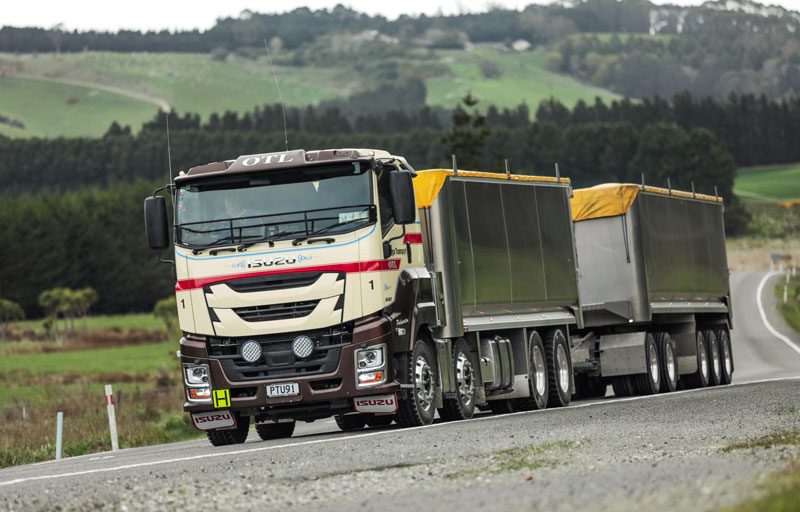
Keeping pace
First up is Peter’s bulky. Having pursued him back to base from the Waitaki, we meet him at Hewvan Timber on Tiverton Street, a block away from OTL’s yard. The truck is parked at the loading ramp taking on its last load for the day, wood chip for delivery the following morning, leaving the truck all up at 36-tonnes. Pete keeps an eye on proceedings from the side lines. Jovial, enthusiastic and immediately up for a good yarn, he wastes no time delving into the merits of his new charge.
“I didn’t think I’d like it at the start, but I’ve gotten used to it,” he comments. His truck being only five months and 45,000km old, Pete’s still new to the Japanese way. His truck-driving history with OTL has been fully red, white and blue until now. He started with a 454 Ultra-Liner when joining the company in 1998 and got out of it at 960,000km. It was replaced by a Qantum 470, which he took to 970,000km before piloting an Argosy for eight years and 925,000km. In line with OTL policy, all trucks are purchased new and with a manual transmission.
The CYJ530 retains the previous model’s 6WG1, 15.6L, six-cylinder motor in Euro-5 trim. Official outputs are 382kW (520ps/512hp) and 2256Nm (1664lb/ft). While it gets along well enough with a deep rumble typical of a large-capacity motor, it must be said this old war horse is showing its age. It still has its advantages, sure. For example, while its rivals Hino and Fuso both run 13L engines in their 700 and Shogun models, and UD an 11L, there’s no doubt the big 6WG1 will be the least stressed under load. It must also be remembered that with this motor, Isuzu offers the highest power and torque outputs of the Japanese OEMs in the all- important 8×4 configuration.
However its delivery is behind the curve, so to speak. Peak power sits at 1800rpm, way up in the rev range and long after the 900 – 1300rpm torque plateau has dropped off by more than 200Nm, which may mean the transmission sees its share of action to keep it on the boil. Speaking of which, Isuzu is the only Japanese OEM to offer the trusty 18-speed Roadranger in its latest heavy trucks (Hino still offers it in the older Euro-5 700), undoubtedly a real point of difference for the brand among buyers looking for just that.
As we hinted in the intro, with UD and Isuzu under one umbrella, we wouldn’t be surprised to see mechanical developments in the big Suzi’s future.
Pete usually traverses the mid-to-lower South Island, from Rangiora to Invercargill and inland to Cromwell. “This hangs onto hills better than I thought it would,” he comments, citing the Kilmog as an example as we really have nothing challenging to judge it against on our trip back to Pete’s home base of Oamaru.
“I’m down to the low box, probably still in the same gear as I was in the Freightliner – maybe half a gear down if anything – but not doing the same speed. It goes all right. But you have to watch it on the Canterbury plains when cruising along … In the Argosy, I could hear the speed, this is a lot quieter and more refined,” he says with a laugh. More on that later.
“For fert work at the airstrips, we really want a manual transmission to manage the rough country,” he adds.
Pete runs 50MAX and it seems he encounters similar issues to the Neweys featured last month. “We do a lot of contract work for farmers in South Canterbury. You can’t even get 50 tonnes across a lot of the small bridges. We often cart across wooden bridges and have to cut it right back to 45 tonne,” he says.
The bins and trailer are by Lusk Engineering in Ashburton. “They build good gear; we’re happy with them,” says Peter. “We’ve got the bins the way we like them now, high enough to accommodate greater loads, so all new bulk trucks will get these going forward.”
There’s not much else on it. Roadrunner supplied the hydraulic tanks, feeding an Edbro ram, and both trucks feature Alcoa alloys – simple, to the point, for the job.
Turning on a dime
Talking weight leads us to retardation. The GIGA features Isuzu’s air-operated exhaust brake as well as its magnetic driveshaft retarder. Pete comments the auxiliary braking isn’t as strong as expected: “At 40-tonne it’s okay, but when you’re running at 50-tonne you’re often on the brakes to maintain speed.”
However, he’s full of praise for the AEB, relating it wasn’t long before it came to his aid when an inattentive driver indicated to turn left before turning right ahead of his truck.
Colin would later share a similar sentiment about the GIGA’s retardation: “To me, the braking used to be stronger. The retarder works alright, but it really depends on how you drive them.” He should know… for the past 12 years or so, he’s only driven Isuzus on stock work.
First starting with OTL in 2000, Colin piloted an Isuzu for about six years and 400,000km. “That was a good truck, the only thing that went wrong was the high-low split on the gearbox,” he comments. After a stint on a Scania with Beckers, he returned to OTL in about 2011 and drove a Qantum for about 300,000km. In 2016 Colin returned to the Isuzu fold, piloting a previous-generation GIGA for some 700,000km in six and a half years before his new GIGA arrived. At the time of our visit, he’d covered 47,000km in six months.
It’s day two with the OTL team, and Colin’s job for the day is to collect cattle from local farms for the Palmerston sale the following day. OTL’s stock units run Delta crates and (on the new models) MD trailers, although Colin tows his older TES trailer. The decks are built in-house – and OTL does the paint itself too.
On the trailers, Colin says: “The trailers have been spec’d and set down so that the bottom three pens are deep to avoid back rub on big cattle.”
One aspect of Colin’s daily operation that’ll have a few eyebrows raised in the stock-truck driving fraternity is the A-frame drawbar on the trailer – as opposed to a telescopic drawbar usually fitted without so much as a second thought in 2023.
“Yep, I know, but I like it,” says Colin. “The amount of unhooking and hooking up we do some days, those bloody big telescopic ones are too much to handle if they drop. Plus there’s a lot of working bits in them. These are simple and so easy to handle.”
Interestingly, when we dropped the trailer to shoot off and load the animals at Logan Rowland’s farm in Waikouaiti, the trailer drawbar did in fact sink in the loose gravel. It was a one-handed effort to right it as Colin backed in. “I’ve seen trucks with telescopics come over the weighbridge with the trailer hooked up, but not pull it on, then come across again truck- only. The difference is 100kg. My back isn’t going to last long lifting that!”
Horses for courses … what you’re used to, or simply what you prefer. At the end of the day that’s what it comes down to … take your pick.
Like Pete, Colin runs 50MAX. Having done his rounds to local farms, Colin’s moving 52 heads of cattle in this first truck and trailer load to the sale, weighing in all up in the mid-40-tonne range.
“One thing I’ve noticed,” he says, “is that the truck doesn’t like it if the front pens on the truck are full.” Interestingly, Peter would comment that there’s the odd jolt from the second steer when his truck is not fully loaded.
What both can agree on, though, is the GIGA’s excellent steering lock. We noticed it too witnessing Colin exit a tight rural drive after one of the collections, and thought back to our March 2018 test with Robert Wood in the Stephenson Transport GIGA, doing a U-turn on a dime. A glance at the spec sheet reveals impressive maximum inner wheel angles of 47° and 39° at the first and second steers at full lock.
Improved inside
“Really, it’s much the same as the old ones,” Colin says. “They’re reliable. You get into them in the morning and they start and that’s all you need, isn’t it?” Ah, there it is again.
“On the hills, I just let the others pass if needed. Horsepower doesn’t worry me. Anyway, I keep up with Barry Ritchie (better known as Spoon) who drives the Freightliner stock unit. Plus, I don’t need to have to stretch out when I climb out at the end of the day,” he quips.
In fact, Peter and Colin both comment on the GIGA’s improved ride comfort – like its predecessor, the CYJ runs on front parabolic leaf springs and double-acting shock absorbers, although the rear now rests on an eight-bag air suspension and hydraulic shock absorbers over the old model’s four-bag setup. They also both approve of the enhanced interior environment.
“The biggest difference between this one and the old one is the interior,” Colin remarks. “Everything’s at your fingertips,” Pete adds. Indeed, everything feels well-built, solidly fitted and hard-wearing.
The cab is dominated by a squared-off dash that provides more space for radios, auxiliary switches and storage compared with the rounded-off design of the previous version. The driver faces a chunky, airbag-equipped steering wheel (similar in design to the previous-gen D-Max) with controls for the cruise on the right spoke and for the comprehensive multi-information display on the left. That colour display is flanked by a large, clear rev counter and speedo – the instrumentation is clear and easy to understand.
The instrument binnacle is surrounded by six switches and a pair of air vents for the driver (the passenger gets two of their own). Isuzu’s 6.2in Android touchscreen infotainment system and electronic climate control sit directly to the left. In addition to radio and Bluetooth connectivity, the infotainment system also provides for external camera inputs, navigation, reverse sensors and tyre pressure monitoring. Just below these are another two rows of large, easy-to-press switches. The centre console offers a shallow storage bin and dual cup holders alongside the gear lever. There’s a shallow centre storage cubby between the seats and two surprisingly narrow overhead lockers.
Entry is an easy four-step process with the driver’s door opening to 88° and the passenger’s to 70°. The driver occupies a heated and ventilated Isringhausen seat, while the passenger’s is rigidly mounted though not uncomfortable. Cab space is good, the Isuzu benefitting from less division and clutter than the UD and Fuso, with their bulky centre consoles. There’s 671mm of space behind the seats, in which is a simple bunk.

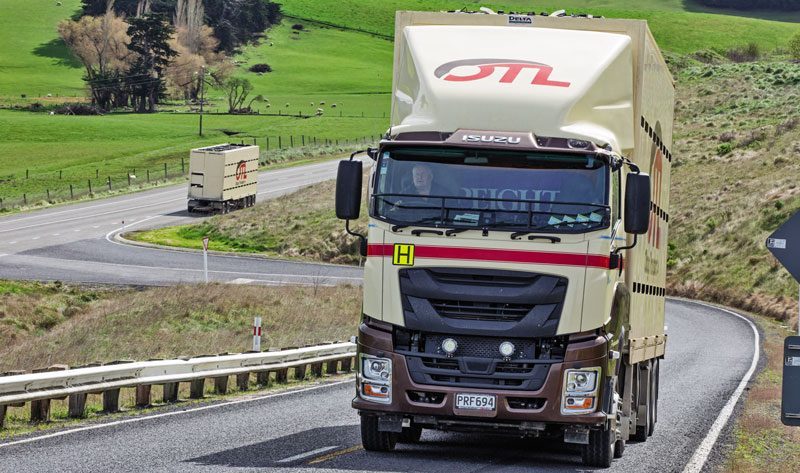
Perception and reality
“They’re easy to drive, comfortable. They’re honest trucks; people grow to like them,” Peter would comment. Indeed, if one trait is carried through the generations of big Isuzus, it would be their charm as honest, hard workers. Operations like OTL’s prove this, the GIGA fits with the company’s honest-to-goodness operations (so much so that there’s a fourth in the workshop being set up as a dropsider).
Despite all this, it’s the ‘flash’ end of the market that tends to catch the eye of drivers these days – a shame, given there’s still plenty of space in the market for trucks like the GIGA … especially now that its safety spec is on par with the best out there. We can’t wait to see what the future holds for this Japanese manufacturer, a name that’s worth so much to so many, as it enters its forthcoming era.
BIG SAFE SUZI
It stands for Advanced Driver Assistance System and it makes the new GIGA like none that has preceded it. So, what’s in the big Suzi’s ADAS safety dowry? There are a few well-known acronyms for sure, but others that might raise an eyebrow or two.
Active
Adaptive Cruise Control (ACC) – Maintains a preselected following distance when cruise control is engaged. Not available on manual transmissions.
Customisable Speed Limited (CSL) – Monitors the fuel injection volume to the engine so the truck can’t exceed a pre-set speed.
Anti-lock Braking System (ABS) – Prevents wheel lock-up and therefore loss of control.
Electronic Stability Control (ESC) – Sensors monitoring driver input and vehicle control reduce power or apply individual wheel braking if understeer, oversteer, or rollover is detected.
Advanced Emergency Braking (AEB) – The truck brakes automatically to avoid a collision.
Forward Collision Warning (FCW) – Raises the alarm pre-AEB.
Distance Warning System (DWS) – Helps maintain a safe distance from the vehicle ahead by warning if a pre-set distance is reached. The driver has four pre-set minimum distances to choose from.
Traffic Movement Warning (TMW) – Monitors stationary traffic and alerts the driver if it starts to move. Handy at the lights if you’re not paying attention.
Lane Departure Warning (LDW) – Raises the alarm when the truck wanders from the lane.
Vehicle Assistance Technology (VAT) – Provides early detection of potential risks.
Anti-skid Regulator (ASR) – Traction-assist mechanism that detects when one drive wheel is spinning faster than another on loose surfaces. Torque is reduced and/or the brakes applied to the spinning wheel.
Hill Start Aid (HSA) – When stopped on a hill, the brake pressure is retained until the clutch is released (or eight minutes), preventing roll-back when starting. Available on manual transmission as well.
Driving beam Lights (ADB) – Adaptive headlights. Automatic Lighting System (ALS) – Monitors exterior light levels and turns head- and tail-lights on when required.
Cab Tilt Warning (CTW) – Driver warning in the event the cab is not fully locked in position.
Passive
- ECE-R29 Cabin
- Dual Airbags (driver and front passenger)
- Seatbelt pre-tensioner (driver and front passenger)
- Anti-intrusion bars in the doors
- Light-up cornering lamps
Special thanks
A hearty thanks to Carey Turner, Trudey Helm, Peter Stevenson and Colin Foley, for allowing us a glimpse into OTL and to sample not one, but two, new GIGAs in the most ideal of operations.
To the team at Dunedin’s Cooke Howlison Isuzu, thank you for your support with the requisite technical information. And to Dave Ballantyne, GM at Isuzu Trucks New Zealand, for your continued support of our publication.

Read more
The right man for the job
0 Comments29 Minutes
Legendary ambition
0 Comments36 Minutes
Hard Fought!
0 Comments40 Minutes
Postal Trifecta
0 Comments29 Minutes




















